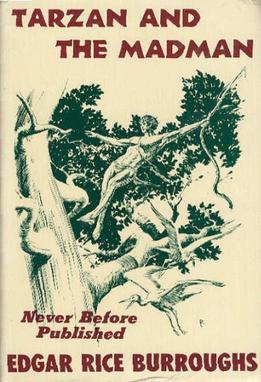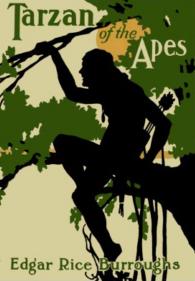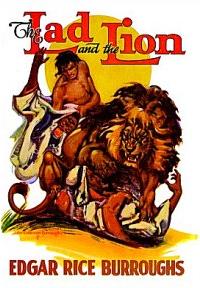
Edgar Rice Burroughs was an American writer, best known for his prolific output in the adventure, science fiction, and fantasy genres. Best known for creating the characters Tarzan and John Carter, he also wrote the Pellucidar series, the Amtor series, and the Caspak trilogy.

John Carter of Mars is a fictional Virginian soldier who acts as the initial protagonist of the Barsoom stories by Edgar Rice Burroughs. A veteran of the American Civil War, he is transported to the planet Mars, called Barsoom by its inhabitants, where he becomes a warrior battling various mythological beasts, alien armies and malevolent foes. Created in 1911, the character has appeared in novels and short stories, comic books, television shows and films, including the 2012 feature film John Carter, which marked the 100th anniversary of the character's first appearance.

Tarzan of the Apes is a 1918 American action/adventure silent film directed by Scott Sidney starring Elmo Lincoln, Enid Markey, George B. French and Gordon Griffith.

At the Earth's Core is a 1914 fantasy novel by American writer Edgar Rice Burroughs, the first in his series about the fictional "hollow earth" land of Pellucidar. It first appeared as a four-part serial in All-Story Weekly from April 4 to 25, 1914. It was first published in book form in hardcover by A. C. McClurg in July, 1922.

Tantor is a generic name for elephants in Mangani, the fictional language of the great apes in the Tarzan novels of Edgar Rice Burroughs. In Burroughs's works a number of elephants appear under the name of Tantor, most notably one particular bull elephant the ape man befriends in his youth in the first Tarzan novel, Tarzan of the Apes and in the 1999 Animated Walt Disney film he is a red African Forest Elephant and friends with the ape Terk.

Jungle Tales of Tarzan is a collection of twelve loosely connected short stories by American writer Edgar Rice Burroughs, comprising the sixth book in order of publication in his series of twenty-four books about the title character Tarzan. Chronologically the events recounted in it occur within Chapter 11 of the first Tarzan novel, Tarzan of the Apes, between Tarzan's avenging of his ape foster mother's death and his becoming leader of his ape tribe. The stories ran monthly in Blue Book magazine, September 1916 through August 1917 before book publication in 1919.

Tarzan and the City of Gold is a novel by American writer Edgar Rice Burroughs, the sixteenth in his series of twenty-four books about the title character Tarzan. The novel was originally serialized in the magazine Argosy from March through April 1932.

Tarzan and the Madman is a novel by American writer Edgar Rice Burroughs, the twenty-third in his series of twenty-four books about the title character Tarzan. Written from January to February 1940, the story was never published in Burroughs' lifetime. It was first published in hardcover by Canaveral Press in June 1964, and in paperback by Ballantine Books in February 1965.

Tarzan: The Lost Adventure is a novel credited to Edgar Rice Burroughs and American writer Joe R. Lansdale, based on an incomplete fragment of a Tarzan novel, written by Burroughs, which had been left unfinished at his death. The book was serialized in four parts by Dark Horse Comics, before being published as a single volume in 1995.

Tarzan's Hidden Jungle is a 1955 black-and-white film from RKO Pictures directed by Harold D. Schuster and starring Gordon Scott in his first film as Tarzan, taking over the role from Lex Barker, who had in turn followed Johnny Weissmuller in the series. The film about Edgar Rice Burroughs' ape-man also features Vera Miles and Jack Elam. It was the last of twelve Tarzan pictures released by RKO.

The Adventures of Tarzan (1921) is a 15 chapter movie serial which features the third and final appearance of Elmo Lincoln as Tarzan. The serial was produced by Louis Weiss, written by Robert F. Hill and Lillian Valentine, and directed by Robert F. Hill and Scott Sidney. The first chapter was released on December 1, 1921.

Tarzan and the Valley of Gold is a 1966 Eastmancolor adventure film starring Mike Henry in his debut as Tarzan. The Panavision film, produced by Sy Weintraub, written by Clair Huffaker, and directed by Robert Day, is remembered for its very James Bond-like portrayal of a tropical-suited, globetrotting Tarzan. It was released on July 1, 1966.

Tarzan and the Lost Safari is a 1957 action adventure film featuring Edgar Rice Burroughs' famous jungle hero Tarzan and starring Gordon Scott, Robert Beatty, Yolande Donlan and Betta St. John. Directed by H. Bruce Humberstone, it was the first Tarzan film released in color, Eastman Color. It was also MGM's first Tarzan film since 1942 and filmed in Nairobi, British East Africa. The character of Jane does not appear in this motion picture.

Tarzan and the Trappers is a 1958 action adventure film featuring Edgar Rice Burroughs' famous jungle hero Tarzan and starring Gordon Scott, Eve Brent, Rickie Sorensen and Lesley Bradley. It was filmed as three pilot episodes for a television series which were edited into a feature film when the project was abandoned, and so was released in black and white rather than color, like other contemporary Tarzan films. The film did finally appear on television, but only in 1966. It was shot in Chatsworth, California.

Beyond Thirty is a short science fiction novel by American writer Edgar Rice Burroughs. It was written in 1915 and first published in All Around Magazine in February 1916, but did not appear in book form in Burroughs' lifetime. The first book edition was issued by Lloyd Arthur Eshbach's Fantasy Press fanzine in 1955; it then appeared in the collection Beyond Thirty and The Man-Eater, published by Science-Fiction & Fantasy Publications in 1957. The work was retitled The Lost Continent for the first mass-market paperback edition, published by Ace Books in October 1963; all subsequent editions bore the new title until the Bison Books edition of March 2001, which restored the original title.

Beyond Thirty and The Man-Eater is a collection of two short novels by Edgar Rice Burroughs. Both were written in 1915; The Man-Eater, a jungle adventure, was first published as a serial in the New York Evening World newspaper from November 15–20, 1915, while Beyond Thirty, a science fiction story, was first published in All Around Magazine in February 1916. Neither work appeared in book form in Burroughs' lifetime. The first book versions were limited editions were issued by Lloyd Arthur Eshbach's Fantasy Press fanzine in 1955; the two works were then published in a combined edition under the present title by Science-Fiction & Fantasy Publications in 1957, through which they first reached a wide readership. Both works have since been published separately.

The Bandit of Hell's Bend is a Western fiction novel by American writer Edgar Rice Burroughs, published in serial form in the Argosy All-Story Weekly in September and October 1924. The book version was first published by A. C. McClurg on June 4, 1925.

Tarzan is a series of 24 adventure novels written by Edgar Rice Burroughs (1875–1950) and published between 1912 and 1966, followed by several novels either co-written by Burroughs, or officially authorized by his estate. There are also two works written by Burroughs especially for children that are not considered part of the main series.

The Monster Men is a 1913 science fiction novel by American author Edgar Rice Burroughs, written under the working title "Number Thirteen". It first appeared in print under the title of "A Man Without a Soul" in the November, 1913 issue of All-Story Magazine, and was first published in book form in hardcover by A. C. McClurg in March, 1929 under the present title. It has been reissued a number of times since by various publishers. The first paperback edition was issued by Ace Books in February 1963.

The Lad and the Lion is an adventure novel by American writer Edgar Rice Burroughs, written in February 1914. His working title for the piece was "Men and Beasts." It was first published as a three-part serial in All-Story Weekly in the issues for June 30, July 7, and July 14, 1917. The story was the first by Burroughs adapted to film, the movie appearing about the same time as the print serial. Despite this distinction, the story did not appear in book form for over twenty years; only after a remake of the film appeared was the first book edition published, by Burroughs's own publishing firm, Edgar Rice Burroughs, Inc., in February 1938. The text was apparently expanded for book publication, as certain incidentals of the story reflect the political situation of Europe in the late 1930s rather than the mid-1910s. The book was reprinted by Grosset & Dunlap in 1939 and Canaveral Press in 1964. The first paperback edition was issued by Ballantine Books in September 1964, with a second appearing from Ace Books in May 1974, reprinted in June 1982.




















